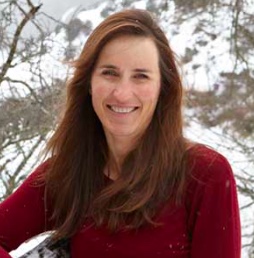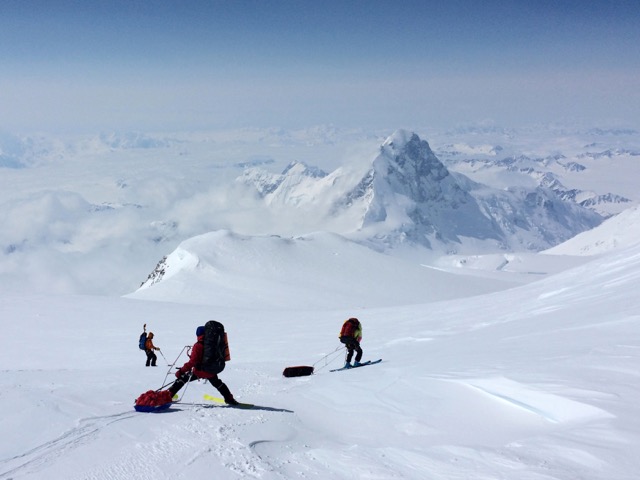Interview by Adele Long
Hi Cathy, thanks for agreeing to do this interview. Starter question, how long have you been a member of the AC?
Since 2012.
What made you join?
The honest answer is because Sandy Allen had invited me on his Nanga Parbat expedition, and he thought we could get some money from the AC. Obviously I was aware of the existence of the AC, but had a weird set of slightly contradictory stereotypes; first that it was full of Victorian gentlemen and only a certain type of chap or chappess would be eligible to join, second that it was full of people who were incredibly hard core and ordinary alpine climbers were not invited. Neither of which is fair or true. And then of course, I don’t actually live in England so how useful is the Club if you don’t live in England or possibly even London? Those are all the things that stopped me from joining and it was Sandy and the Nanga Parbat expedition that made me think, ‘well okay let’s give it a go’.
So what got you into mountaineering?
Rock climbing. I am South African and although we have some reasonably high mountains - getting on for 3500m - we don’t have much in way of snow but we do have some very good rock. So as soon as I got to university I started rock climbing. Back in the day it was all trad, and I loved it. After that it was about curiosity; what would it be like to try a longer route, what would it be like to try a mountain, what it would be like to find somewhere colder? I started off in central Africa and the Bolivian Andes, and being South African travelling under sanctions was difficult, possible, but complicated. Then I did a season in the Alps, and it seemed astonishingly expensive. I think [mountaineering] has always been driven essentially by curiosity. Can I do this thing? Can I deal with this thing? Let’s give it a try!

You now live in Andorra, how does that impact on your mountaineering?
In many ways it’s very good. I am right up in the mountains but also with wonderful weather. As a South African I expect the sun to be shining! That’s why I am not very good at navigation, the idea of having to do dead-reckoning on the top of Ben Nevis is like, ‘why’? I choose to live in places where the sun shines. There’s alpine climbing here and I do a lot of ski mountaineering now; there’s access to amazing rock climbing in Catalunya and south of France. I guess I do miss a bigger community of climbers, of course Spain has some astonishingly good climbers, but I miss the community of other English speaking climbers. This is one of the impulses to joining the AC.

What is your best mountaineering memory?
I find those ‘best of’ questions really hard to answer. Some of the best trips I have done have not necessarily been the very big ones where you have a big plan, lots of careful preparation and you execute your plan and nothing goes wrong and you get to your summit. That’s interesting and satisfying, but the very best trips are always the ones when something goes completely wrong. One of the best trips I ever did was when I failed the climb the Nose on El Capitan. We got 12 pitches up, the weather was very hot, we were pulling up too much water - I couldn’t even bring up the haul bag on my own - it was horrible. I had had this big dream about big wall climbing and then after a third of the way up the Nose decided I hated it. It didn’t work [for me]. I wasn’t that kind of climber. So we abseiled off, dumped Yosemite as the plan, got a hold of the Classic Climbs in the Eastern Sierras guidebook and just went off in a hire car and had this brilliant trip peak bagging multi-pitch rock routes in the Sierras, all one day routes. It was amazing and our plan consisted of the two of us, the knowledge we had, the guide book and ‘what shall we do tomorrow’? So the best trips have actually been a combination of spontaneity, a really good climbing partner, a beautiful corner of the world and an element of surprise as to how it will turn out.
So what was the most challenging route you have done?
The Mazeno Ridge on Nanga Parbat. That was HARD, I was punching above my weight as an alpinist on that trip. Alpine style at that altitude over that time period and then complete commitment to the route, I mean if anything had gone seriously wrong we did not have a lot of options. I suppose eventually we did reach a point where, for me, the level of risk and commitment required was just too much. I bailed after the first failed summit bid. I was using what I had left to get off the mountain safely, whereas Sandy and Rick, who were better climbers than me, were prepared to put in just another level of commitment, of risk, to continue. That’s not what I climb for. I want to finish the day with all my fingers and toes. That was probably the hardest thing I have ever been on and probably the hardest thing I will ever be on. I don’t think any one peak is worth everything. It’s more about a life-style over time and that does involve, among other things, not getting badly injured, staying fit and healthy and being engaged in the mountains over decades and hopefully all my life.

Have you ever made a mistake?
I have done the true classic, which is to abseil off the end of the rope, and, no, I wasn’t on the ground at the time! It was interesting because, out of a 12 month period I had probably spent 9 months of it climbing and this happened towards the end of the summer and I had already done hundreds of abseils. We ended up on a multi-pitch crag somewhere near Zurich, we had done a nice long route, we are abseiling back down, I am going first, and there were possible abseil points all over the place, mostly threads. I was looking at these various options as I was going down and thinking if I could stretch the abseils into one more instead of two. I spotted a possible belay thread and I was watching it trying to see if I could eke out the rope to get to it and I wasn’t watching the end of the rope. We didn’t have knots tied in the end of the rope, and the rope went through. It was a bit like the classic car crash, it feels like it is happening in slow motion and it feels very dispassionate. The rope went through and I thought ‘oh f**k’. There was a small ledge just below me and I thought I might stop on it. I hit it… and rolled off. It was like ‘Ok that plan didn’t work’. Then I hit a very small tree, more of a bush, which I managed to hook with my elbow. I wrapped both hands around it and climbed back onto the little ledge and sat there and waited for Stephen to come and rescue me!
I had an entire rope length left. I’d have died or been horribly injured, without a doubt. It wasn’t that I didn’t know how to abseil or didn’t understand the risks, I was being complacent and for the sake of speed we were not doing some of the extra safety things you do for abseils like tying knots in the end of the rope or using the prussic knot. When you have climbed for a long time so many things are completely automatic. I always try to remember that the downside of that familiarity is the danger of complacency.
Mountaineering aside, what else is important you in your life?
Mountains are woven into almost all of [my life], really. The other thing that interests me is story-telling. I make a living as an inspirational speaker for business, and I use experiences of working with teams in the Himalaya to talk to businesses about team work, which is fun as I get to bungy jump into these really fancy companies and have a look at the ways in which you could live your life… and then I get to go home. But the whole process of sharing experiences interests me. I love the rise of social media just because it is a way of sharing experiences and stories in a very visual way. Photography hugely, video to a lesser extent – I love taking it but don’t like editing it afterwards – speaking to climbing clubs or corporate clients, are all ways of distilling experiences down to an engaging story. I have written one book I am proud of about my four trips to Everest, ‘Just for the Love It’. I never meant to be an Everest junkie. I feel a bit awkward about being seen as that, because I went back so often. Every time was meant to be the last, but life does strange things.

Is there anything you think the AC should do to further mountaineering or support its members?
I find that a little difficult to answer as I feel that I am not fully engaged in all that the AC has to offer, partly because of not living in the UK. But I am now trying to engage more by, for example, making use of the equipment hiring services - we are taking one of the DeLorme InReach global messaging and GP locator units (see AC Newsletter March 2016) when we go to Logan in May (Eagles Ski Club). I am working on a research project to do with my corporate clients and am again interested in using mountaineering as a metaphor and I am going to be heading into the AC Library this week to do some research. And I hope in the future to make more use of the AC opportunities to meet other members. I don’t think I have ideas about what else the AC can do; at this point it is more about me as a member and how I can make more use of the resources of the Club.
Thanks Cathy. There is so much more I want to ask, but may be another time?
You can read more about Cathy and her mountaineering exploits on http://cathyodowd.com/adventures/ and her book ‘For the Love of It’ is available from on-line booksellers.
